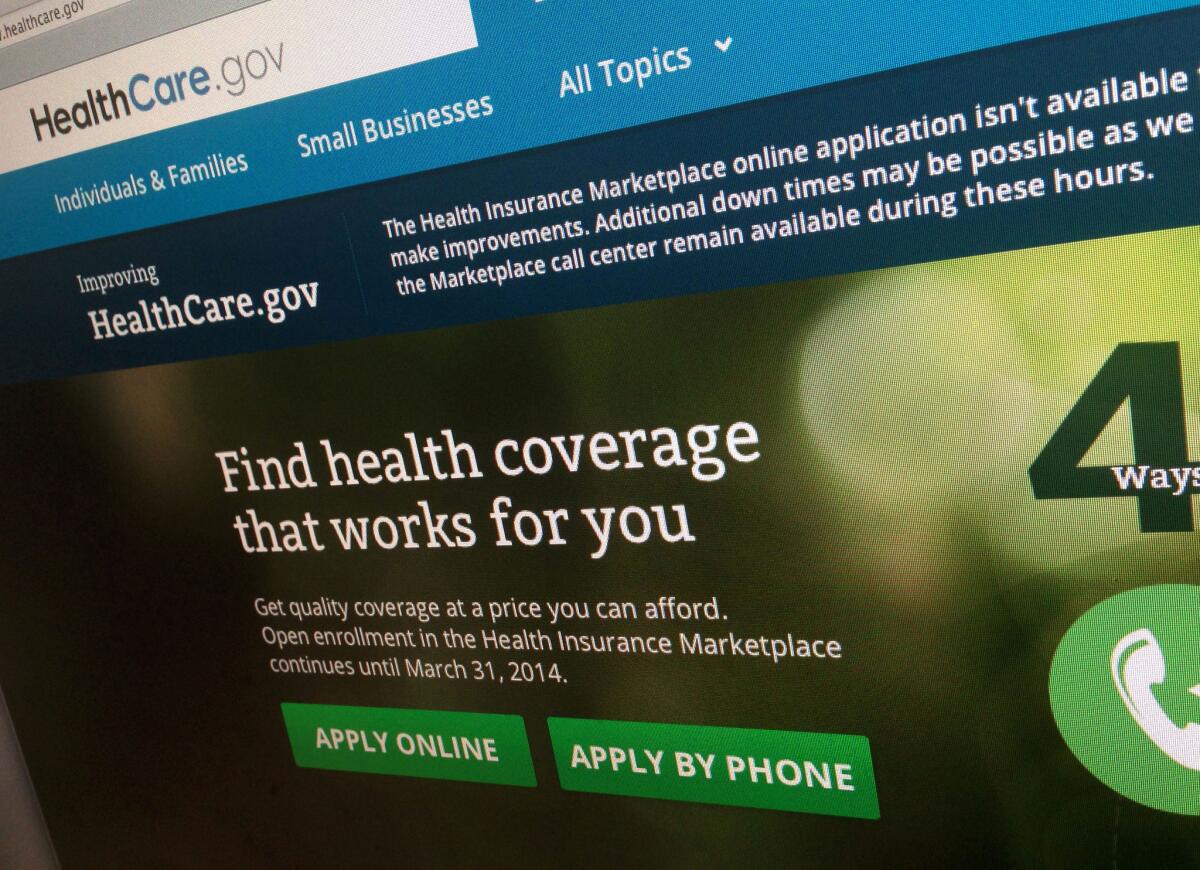Opinion: The genesis of Obamacare’s disputed provision on insurance subsidies

The Times ran multiple opinion pieces last week -- by me, by the editorial board and by op-ed contributors -- arguing that, contrary to what the U.S. Circuit Court of Appeals for D.C. ruled, the 2010 healthcare law makes insurance subsidies available in every state, not just the 14 that established their own insurance exchanges.
To which some readers have asked, reasonably enough, why does the text of the law seem so clearly to say otherwise? For example, Michael Robertson, a tech entrepreneur who’s no fan of Obamacare, asked via Twitter, “Why mention ‘state exchanges’ in the context of subsidies if everyone gets them? That’s highly illogical.”
Robertson and others have also pointed to warnings by MIT economist Jonathan Gruber in 2012 that states would lose the tax credits if they didn’t set up exchanges. Gruber -- now the Wall Street Journal editorial board’s favorite Obamacare supporter -- helped Massachusetts build and implement its healthcare reform effort and advised the Obama administration and Congress on what became 2010 Patient Protection and Affordable Care Act.
The provision at issue determines the size of the tax credits available through the law. It says the amount will be based in part on the size of the monthly premiums for plans that recipients “enrolled in through an exchange established by the state” under the procedures set forth elsewhere in the act.
So, why the reference to “established by the state,” a phrase upon which the D.C. Circuit Court hung its entire ruling barring subsidies in states that had the federal government set up their exchanges? (The ruling is on hold pending an appeal.) According to my sources, who, unlike Gruber, were involved in the actual drafting (but who asked for anonymity because they no longer work for the government), the phrase stemmed mainly from the Senate’s desire to distinguish its approach from the House’s.
Committees in both the House and the Senate started working on a healthcare overhaul early in 2009, as did the Obama administration. The House Energy and Commerce Committee’s draft came out in July of that year, the Senate Health, Education, Labor and Pensions Committee approved its version in mid-September, and the Senate Finance Committee countered with its own proposal a few weeks later.
The House bill would have put the federal government in charge of launching the exchanges, although states could opt out and run their own. So the House clearly intended no difference from state to state in the availability of subsidies. The two Senate committees, in turn, called on states to set up exchanges. The state-based system was more appealing to a number of stakeholders who didn’t like the idea of a monolithic federal approach.
The two Senate panels weren’t entirely in sync on the exchanges. The Health, Education, Labor and Pensions Committee called on the federal government to establish exchanges in states that did not. Residents of a state that didn’t set up an exchange wouldn’t automatically be ineligible for the bill’s subsidies, however. Instead, the subsidies, which took the form of premium credits the government would pay directly to insurers, would still be denied only if the state failed to adopt the insurance reforms required by the bill. In other words, the subsidies were supposed to incentivize states to change their insurance regulations, not to set up exchanges.
The Finance Committee had a different back-up plan. If a state didn’t set up an exchange within two years, the bill called for the federal government to hire a “nongovernmental entity” to operate the state’s exchange.
Unlike the HELP Committee bill, the Finance Committee didn’t have a provision denying subsidies to states that didn’t enact the requisite insurance reforms. But it did say that the size of the subsidies -- which took the form of tax credits -- would be based in part on the premiums charged for the plans families “enrolled in through an exchange established by the state.” The point, my sources said, was to make sure the tax credits didn’t flow outside the exchanges, which everyone assumed at the time would be established by the states.
Notably, the Finance Committee’s report on the bill makes no mention of subsidies being denied to states that didn’t set up their own exchanges. The only eligibility limitations discussed are an individual’s income and immigration status and whether that person can obtain affordable and comprehensive coverage from an employer.
When Senate Democratic leaders merged the two committees’ bills into a single proposal that November, they used the Finance Committee’s language on exchanges with few changes. A potentially telling one is the deletion of the committee’s proposal to have non-governmental entities operate exchanges in states that didn’t set up their own. Instead, the bill required the federal government to establish and operate “such exchange” -- a formulation that the 4th Circuit Court judges said was meant to signify the equivalence between state- and federally established exchanges.
The HELP Committee’s approach to exchanges was all but ignored, including the language that explicitly rendered states ineligible for subsidies if they failed to enact certain insurance reforms. That may be the clearest evidence that the idea of withholding subsidies never made it past the HELP Committee.
Having said all that, the provision in dispute is a forehead-slapper for anyone who supports Obamacare. Aides who worked on the bill expected to be able to polish it in a House-Senate conference committee, which may explain the sloppy drafting. Those plans were abandoned when the coalition of Democrats and independents that pushed the bill through the Senate over unified Republican opposition lost its filibuster-proof majority in early 2010, leaving Democrats little hope of steering an amended version through the Senate.
Some will argue that whatever Congress meant to say, the administration should be bound by what the law actually says. That’s not unreasonable, and it may ultimately prove to be the Affordable Care Act’s undoing. The subsidies are essential to the law’s reforms in the individual insurance market, and it’s unfair to offer them in some states but not others.
Yet as the Supreme Court has ruled, individual sections of an act can’t be read in isolation. Phrases have to be read in context. That’s why the 4th Circuit upheld the administration’s interpretation of the disputed provision, which the panel said was ambiguous because it conflicted with other parts of the Affordable Care Act.
Obamacare opponents would very much like to believe that Congress was using the subsidies as a stick to punish states that didn’t set up exchanges, but the evidence in the record -- along with interviews with people who helped write the bill -- indicates that there was no such plan. In light of what the rest of the law says, the best explanation for the disputed provision is that the Senate was trying to distinguish its proposal from the House’s, not to withhold subsidies from lower-income Americans unlucky enough to live in states led by Obamacare opponents.
Follow Healey’s intermittent Twitter feed: @jcahealey
More to Read
Start your day right
Sign up for Essential California for news, features and recommendations from the L.A. Times and beyond in your inbox six days a week.
You may occasionally receive promotional content from the Los Angeles Times.







